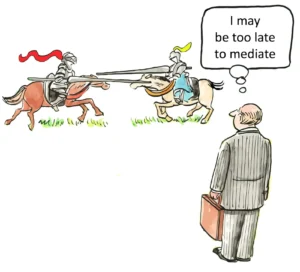Presidential Authority to Terminate Federal Contracts Under the DOGE Cost Efficiency Initiative
The scope of presidential authority to terminate federal contracts has garnered renewed attention following the establishment of the Department of Government Efficiency (DOGE). This executive initiative, formalized through presidential executive order, represents one of the most aggressive attempts in recent history to curtail federal spending through contract termination. The legal framework governing such terminations merits careful examination, as it implicates fundamental questions about executive power, contractual obligations, and the proper stewardship of taxpayer resources.
The federal government’s authority to terminate contracts “for convenience” stands as a unique feature of government contracting, granting federal agencies broad discretion to end contractual relationships when deemed in the government’s interest. This authority has taken on new significance under the DOGE initiative, which has wielded termination for convenience as its primary tool for achieving cost reductions across federal agencies. Between January and February 2025 alone, the federal government terminated 2,425 contracts for convenience and issued stop-work orders on 205 others, resulting in approximately $150 million in de-obligated funds.
The Legal Foundation for Contract Termination
The presidential authority to terminate federal contracts rests primarily on the Federal Acquisition Regulation (FAR), which establishes the regulatory framework governing procurement by federal agencies. The FAR mandates the inclusion of termination for convenience clauses in most federal contracts, providing the government with unilateral authority to end contractual relationships when deemed in its interest. This authority represents a significant departure from commercial contracting principles, where both parties typically possess equal rights and responsibilities.
The termination for convenience doctrine originated during the Civil War era, when the government needed flexibility to adjust procurement as wartime needs evolved. Courts subsequently affirmed this authority, recognizing the government’s need to respond to changing circumstances, particularly during national emergencies. Over time, this doctrine expanded beyond wartime applications to become a standard feature of federal contracting, reflecting the government’s unique position and responsibilities.
The legal foundation for termination for convenience rests on the principle that the government must retain flexibility to adapt to changing circumstances, priorities, and fiscal realities. As the Court of Federal Claims has recognized, the government cannot bind itself indefinitely to contracts that no longer serve the public interest. This principle acknowledges the executive branch’s responsibility to manage federal resources efficiently while fulfilling its constitutional duties.
The Department of Government Efficiency’s Approach
President Trump formalized the Department of Government Efficiency (DOGE) through an executive order on his first day back in office, tasking it with identifying and eliminating wasteful government spending. Under the leadership of Elon Musk, DOGE has aggressively pursued contract terminations as a primary cost-cutting strategy, leveraging the government’s termination for convenience authority to an unprecedented degree.
The executive order implementing the DOGE Cost Efficiency Initiative directs agency heads, in consultation with their DOGE team leads, to review existing “covered contracts and grants” to identify opportunities for termination or modification. This review explicitly aims to reduce or reallocate federal spending, promote efficiency, and advance administration policies. The order establishes an ambitious timeline, requiring agencies to complete comprehensive reviews of contracting policies, procedures, and personnel within 30 days of issuance.
DOGE’s approach represents a significant departure from previous government efficiency initiatives, which typically focused on prospective reforms rather than terminating existing contractual relationships. The scale and pace of DOGE’s contract terminations have raised concerns among government contractors, legal scholars, and some members of Congress about the proper balance between executive discretion and contractual stability.
Termination for Convenience: Legal Framework
The Federal Acquisition Regulation establishes detailed procedures governing the termination of federal contracts for convenience. FAR Subpart 49.1 outlines the general principles applicable to such terminations, including the authority and responsibilities of contracting officers, the duties of contractors after termination, and the procedures for settlement.
When a contracting officer determines that termination serves the government’s interest, they must issue a written notice to the contractor specifying the effective date and extent of termination. This notice must clearly state that the termination is for the government’s convenience under the relevant contract clause, provide any special instructions, and outline steps the contractor should take to minimize the impact on personnel if significant workforce reductions will result.
Following termination, contractors are entitled to compensation for work performed prior to termination, reasonable charges resulting from the termination, and settlement expenses. However, contractors cannot recover anticipated profits on unperformed work—a significant limitation compared to breach of contract remedies in commercial settings. This limitation reflects the government’s special status and its need to maintain flexibility in managing public resources.
Limitations on Termination Authority
While the government’s termination for convenience authority is broad, it is not unlimited. Courts have recognized certain constraints on this power, primarily centered on the requirement that the government act in good faith and not abuse its discretion. As the Court of Appeals for the Federal Circuit stated in T.M. Distributors, Inc. v. United States, “Government officials are presumed to act in good faith, and it requires ‘well-nigh irrefragable proof’ to induce the court to abandon the presumption of good faith dealing.”
This high standard makes successful challenges to termination for convenience decisions exceedingly rare. Contractors must essentially demonstrate that the government acted with specific intent to harm or with a specific intent to deprive the contractor of the benefits of the contract. Mere evidence that the government could have made a better decision or that the termination was financially disadvantageous to the contractor is insufficient.
The government also cannot terminate a contract solely to obtain a better price from another contractor. Such actions would constitute bad faith and an abuse of discretion. However, terminations based on policy changes, budget constraints, or revised assessments of need generally withstand judicial scrutiny, as courts recognize the government’s legitimate interest in adapting to changing circumstances.
DOGE’s Implementation and Legal Challenges
The DOGE initiative’s aggressive approach to contract termination has generated significant legal controversy and potential challenges. The executive order establishing the DOGE Cost Efficiency Initiative directs agencies to prioritize review of contracts with educational institutions and foreign entities, suggesting a policy-driven approach to termination decisions rather than purely efficiency-based considerations.
This approach raises questions about whether DOGE-directed terminations might be vulnerable to legal challenge on the grounds that they represent predetermined policy decisions rather than individualized assessments of the government’s interest in particular contracts. While courts generally defer to executive determinations of the government’s interest, terminations based primarily on categorical policy preferences rather than contract-specific considerations might face heightened scrutiny.
Several contractors have already filed protests with the Government Accountability Office and lawsuits in the Court of Federal Claims challenging DOGE-directed terminations. These challenges generally allege that the terminations were arbitrary, capricious, or motivated by improper considerations rather than legitimate assessments of the government’s interest. While most such challenges face significant hurdles given the deferential standard of review, they highlight the legal tensions inherent in DOGE’s approach.
Contractor Rights and Remedies
When the government terminates a contract for convenience, contractors retain important rights to compensation, albeit more limited than what would be available for breach of contract. Under the FAR, contractors are entitled to recover costs incurred for work performed before termination, reasonable charges resulting directly from the termination, and a reasonable profit on work performed.
The termination settlement process typically involves negotiation between the contractor and a termination contracting officer (TCO). The contractor must submit a settlement proposal detailing its termination costs, which the TCO then reviews. If the parties cannot reach agreement, the TCO may issue a unilateral determination, which the contractor can appeal through the Contract Disputes Act process.
Contractors facing termination should immediately begin documenting costs and preserving records to support their settlement proposals. This includes direct costs for completed work, settlement expenses, and costs associated with terminating subcontracts. Contractors should also implement measures to mitigate termination impacts, as the government may deny recovery for costs that could have been reasonably avoided.
Constitutional Considerations
The DOGE initiative raises important constitutional questions about the scope of executive authority over federal spending. The Constitution assigns Congress the power of the purse, including the authority to appropriate funds and establish programs. While the President possesses significant discretion in implementing congressional directives, this discretion is not unlimited.
The Impoundment Control Act of 1974, enacted in response to President Nixon’s attempts to withhold appropriated funds, restricts the executive branch’s ability to unilaterally decline to spend appropriated funds. When DOGE directs the termination of contracts funded through congressional appropriations, questions arise about whether these actions constitute impoundments that require congressional notification or approval.
The Constitution’s Take Care Clause also requires the President to “take Care that the Laws be faithfully executed.” This provision imposes a duty to implement congressional enactments, potentially limiting the executive’s authority to terminate contracts that fulfill statutorily mandated programs or objectives. Courts have generally been reluctant to intervene in such disputes, viewing them as political questions best resolved between the political branches.
Impact on Federal Contractors
The DOGE initiative has created significant uncertainty for federal contractors, particularly those in sectors targeted for heightened scrutiny. Contractors with existing federal contracts face the possibility of sudden termination, potentially disrupting business operations, workforce planning, and financial projections.
The termination for convenience process can be lengthy and complex, requiring contractors to navigate detailed regulatory requirements while managing the practical challenges of winding down contract performance. Even when contractors receive settlement payments, these typically do not compensate for lost profits on unperformed work, creating financial challenges particularly for small businesses with limited contract portfolios.
Contractors can mitigate these risks through proactive measures, including diversifying their customer base, maintaining detailed documentation of contract performance and costs, and structuring subcontracts to include termination for convenience clauses that align with prime contract provisions. Contractors should also closely monitor DOGE announcements and agency implementation plans to anticipate potential termination decisions affecting their contracts.
Agency Implementation Challenges
Federal agencies face significant challenges in implementing DOGE directives while maintaining compliance with procurement laws and regulations. The executive order’s 30-day timeline for comprehensive contract reviews creates substantial administrative burdens, particularly for agencies with extensive contract portfolios.
The Department of Defense, which accounts for approximately 60% of federal contract spending, has initiated a comprehensive review of its contracting policies, procedures, and personnel in response to the DOGE directive. This review has significant implications for defense contractors, who must navigate uncertainty while the Pentagon reassesses its contractual commitments.
Agency contracting officers bear particular responsibility in this process, as they must make individual termination decisions consistent with both DOGE directives and their independent obligation to determine whether termination serves the government’s interest. This dual responsibility creates potential tensions, particularly when political priorities may conflict with programmatic needs or contractual obligations.
Termination for Convenience vs. Default
The government’s authority to terminate contracts “for convenience” stands in contrast to termination for default, which requires contractor non-performance or other material breach. While termination for convenience provides the government broad discretion to end contracts based on its own interests, termination for default requires specific contractor failures and triggers different legal consequences.
When the government terminates for default, the contractor may be liable for excess reprocurement costs and other damages, and may face negative past performance evaluations affecting future contract opportunities. In contrast, termination for convenience entitles the contractor to compensation for work performed and reasonable termination costs.
The DOGE initiative’s focus on termination for convenience rather than default reflects its policy-driven approach to contract reduction rather than contractor-specific performance concerns. This approach allows for more rapid implementation of administration priorities but may raise questions about whether terminations truly serve the government’s interest as required by the FAR.
Judicial Review and Deference
Courts have traditionally granted substantial deference to executive branch decisions regarding contract termination, recognizing the government’s unique position and responsibilities. This deference reflects both separation of powers principles and practical considerations about judicial competence to evaluate complex policy judgments.
The “well-nigh irrefragable proof” standard for challenging termination decisions creates a high bar for contractors seeking judicial relief. Courts generally presume that government officials act in good faith, requiring clear and convincing evidence of specific intent to harm before finding a termination improper.
This deferential approach reflects judicial recognition that decisions about resource allocation and program priorities involve policy judgments better suited to the political branches than the courts. However, as DOGE implements increasingly aggressive termination policies, courts may face pressure to reconsider the appropriate level of scrutiny for executive termination decisions, particularly when they appear to circumvent congressional spending priorities.
Comparative Historical Perspective
The DOGE initiative represents a particularly aggressive application of termination for convenience authority, but it builds on a long history of executive branch efforts to control federal spending. Previous administrations have implemented various efficiency initiatives, though typically with less emphasis on terminating existing contracts.
The Clinton Administration’s “Reinventing Government” initiative focused on streamlining procurement processes and reducing regulatory burdens rather than terminating existing contracts. Similarly, the Obama Administration’s efficiency initiatives emphasized prospective reforms rather than contract termination as a primary cost-cutting strategy.
The Trump Administration’s first term saw increased use of termination for convenience in certain policy areas, particularly related to environmental programs and international agreements. However, the current DOGE initiative represents a significant expansion in both scale and scope, applying termination authority across virtually all federal agencies and program areas.
Congressional Oversight and Response
Congress maintains significant authority over federal procurement through its appropriations power and oversight responsibilities. As DOGE implements widespread contract terminations, congressional committees have begun examining whether these actions align with legislative intent and appropriations requirements.
The House Oversight Committee has initiated hearings on DOGE’s implementation, focusing particularly on whether contract terminations comply with the Impoundment Control Act and other statutory constraints on executive spending authority. Several members have expressed concern that DOGE’s approach may circumvent congressional spending priorities established through the appropriations process.
Congress retains powerful tools to shape DOGE’s implementation, including the ability to enact legislation specifically prohibiting certain contract terminations, imposing additional procedural requirements, or restricting the use of appropriated funds to implement termination decisions. Whether Congress will exercise these authorities depends largely on political calculations about the popularity of government efficiency initiatives and the specific contracts targeted for termination.
Future Implications and Legal Developments
The DOGE initiative’s aggressive use of termination for convenience authority may have lasting implications for federal contracting practices and executive-legislative relations. If courts generally uphold DOGE-directed terminations, future administrations may view contract termination as a standard tool for implementing policy changes rather than an extraordinary measure.
This approach could fundamentally alter expectations in the federal contracting community, potentially leading contractors to build additional risk premiums into contract pricing or limit investments in contract performance that might not be fully recoverable in termination settlements. Such changes could ultimately increase government procurement costs, potentially offsetting savings from contract terminations.
The initiative may also prompt legislative reforms to the termination for convenience framework, particularly if Congress concludes that current practices undermine legislative spending priorities. Potential reforms could include enhanced procedural requirements, more specific standards for determining when termination serves the government’s interest, or expanded contractor remedies.
Conclusion
The presidential authority to terminate federal contracts under the DOGE Cost Efficiency Initiative represents a significant expansion of executive power over federal spending. While the termination for convenience doctrine has long been a feature of government contracting, its aggressive application as a policy implementation tool raises important legal questions about the proper balance between executive discretion and congressional spending authority.
Contractors facing potential terminations should understand their rights and obligations under the FAR’s termination for convenience provisions, maintain detailed documentation to support settlement proposals, and consider proactive risk mitigation strategies. Federal agencies must navigate the challenging terrain between DOGE directives and their independent obligations under procurement law.
As the initiative continues to unfold, courts will likely face increasing pressure to clarify the boundaries of executive termination authority, particularly when terminations appear motivated primarily by policy preferences rather than contract-specific considerations. Congress, meanwhile, retains significant authority to shape DOGE’s implementation through oversight and legislation.
The ultimate resolution of these tensions will significantly influence the future of federal contracting, executive-legislative relations, and the government’s ability to efficiently manage public resources while respecting contractual commitments and congressional spending priorities. The DOGE initiative thus represents not merely a cost-cutting measure but a significant test of fundamental constitutional principles governing the separation of powers and the proper management of public resources.
Citations:
- President Trump Issues Executive Order Directing Agencies to Review Spending
- Federal Acquisition Regulation Part 49: Termination of Contracts
- One Federal Clause Allows DOGE to Cancel Contracts at Will
- Federal Clause Allows DOGE to Cancel Government Contracts at Will
- Be Prepared: Termination for Convenience in Federal Contracts
- Termination Cost Recovery Guide for Federal Contractors
- DoD Launches Contracting Review Under DOGE Initiative
- Executive Order: Implementing the Department of Government Efficiency Initiative
- Major Changes in Federal Contracting Under DOGE Cost Efficiency Initiative
- What DOGE Cost Efficiency Initiative Means for Government Contractors
- New Executive Order Bolsters DOGE Role in Federal Grants
- Recent Ruling on Department of Government Efficiency and FOIA
- DOGE Federal Contracts Canceled as Musk and Trump Cut Spending
- Executive Order Establishing the Department of Government Efficiency
- DOGE Cost Savings and Efficiency Metrics Dashboard
- Legal Challenge to Elon Musk and DOGE’s Control of Government
- Government Contractors Should Prepare for Executive Order 14222 Implementation
- What Recipients Need to Know If a Federal Grant Is Terminated
- President Trump Signs New Executive Order Implementing DOGE Initiative
- Department of Government Efficiency Official Website




















